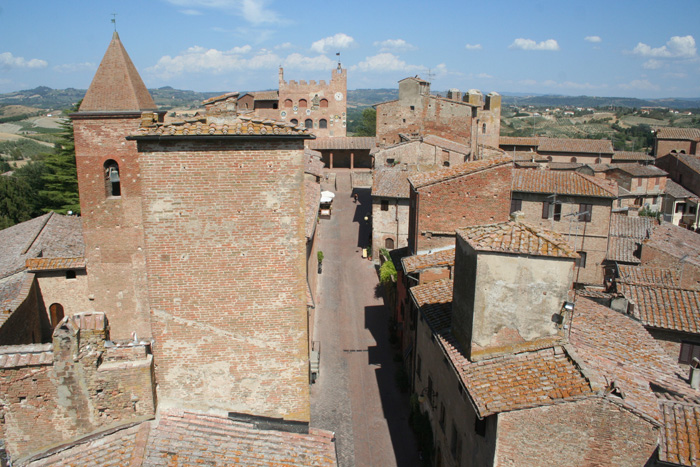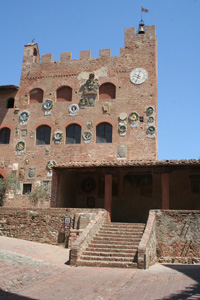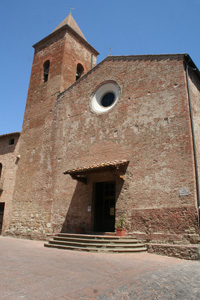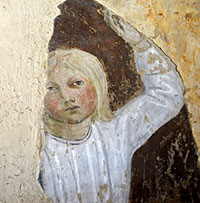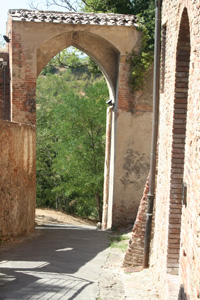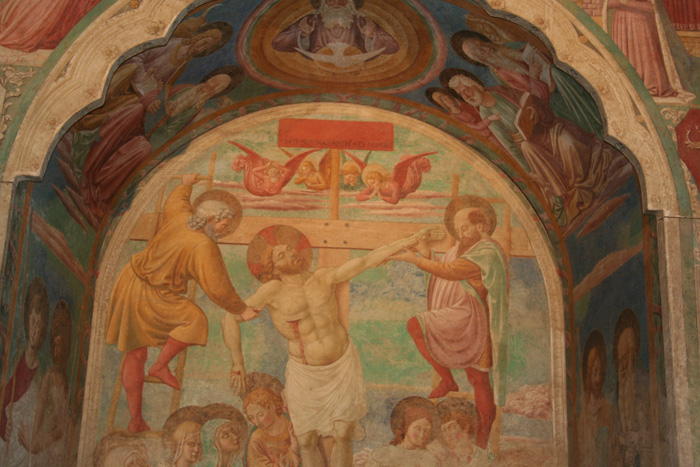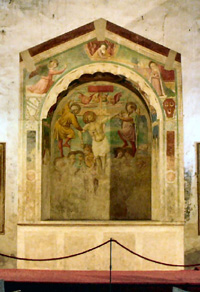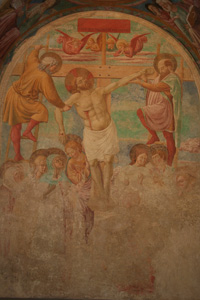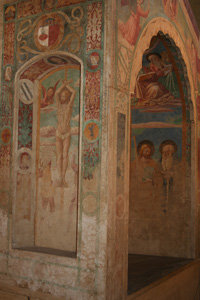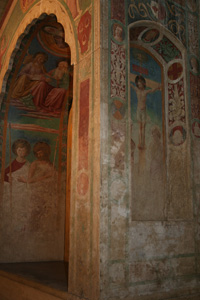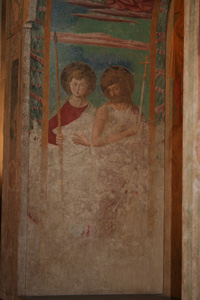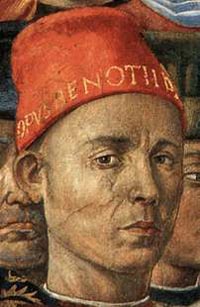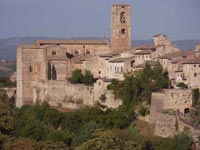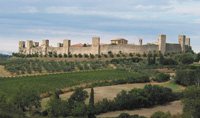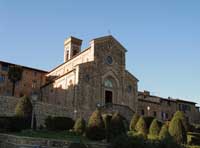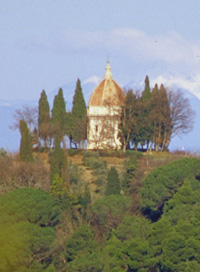Certaldo |
| Certaldo is a small and unspoilt hilltop village with Etruscan origin, very well-preserved in every detail. This small town still retains its ancient part of the original medieval structure with the Praetorian Palace, monasteries, churches, towers, fortifications and the characteristic red brick buildings and roads. The town of Certaldo is divided into an upper part, medieval and more picturesque called Certaldo Alto and a modern part located in the valley below.[1] Certaldo received the Orange Flag, a recognition of quality small towns with a population 15,000 or less. Certaldo was the home of the family of Giovanni Boccaccio, who died and was buried here in 1375. The Museum of Sacred Art was originally an Augustinian convent from the 15th century. Beautifully restored and turned into a museum, it was inaugurated in 2001. The exhibition rooms showcase paintings, sculptures and sacred relics and items. The painting gallery, or pinacoteca, is in the old frescoed refectory of the convent, and today showcases ancient paintings that date back to the 12th century to the 16th century. Here, you can admire works by such distinguished artists as Cenni di Francesco di Ser Cenni, Ugolino di Nerio and Meliore. Among the important works present is a wooden crucifix, from the San Pietro a Petrognano church, which dates back to the early 13th century. It has been attributed to an unknown Tuscan sculptor. It is, indeed, unique in the world of medieval Italian sculpture: the image of Christ, triumphant over Death, has gained much recognition in art criticism thanks to the sculpture's expressive force. Other monuments and Churches Within the Borgo are various buildings of historical and artistic interest such as the various noble houses: Palazzo Stiozzi Ridolfi (14 th century), now private, and Palazzo Giannozzi, across each other on Via Boccaccio, where is also found the 'Tower House' of Palazzo Machiavelli. Palazzo Giannozzi Ancient estate palace, it is now occupied by artisanal shops that carry out current work. Here one finds the "Nail Museum", unusual collection, by the artistcarpenter Giancarlo Masini, composed of nails of all kinds and eras, as well as of implements from a peasant culture and woodcarvings. Church of St. Jacopo and Filippo and Romanesque Cloister The Church of St. Jacopo and Filippo goes back to the 12 th - 13 th century. Inside its single nave, it houses frescoes, sculptures, and glazed terracotta ciboria of the della Robbia School. In the middle, near the bas-relief depicting Boccaccio, is the poet's tomb. The church also houses the urn of the Blessed Giulia (1319-1367), fascinating legends exist on the life of this figure as a cloistered nun. From the Church one enters the Augustinian Convent with an especially striking Romanesque Cloister that allows access to the Blessed Giulia's cell, fully preserved through time. The Ancient Gates of Access to the Historical Borgo At the top of Costa Alberti rises the imposing Porta Alberti that, with the Porta al Rivellino and the Porta del Sole, was one of the ancient entrances to the historical Borgo: the present road connecting Upper and Lower Certaldo is, in fact, of recent construction. The Porta Alberti, preserved almost intact, is placed half way up a very steep climb, as imposed by the era's defensive architecture, so that it would have been extremely difficult to knock it down, even with the aid of battering rams, because of the steep slope. The Porta al Rivellino, which commands a beautiful view of the valley, was the most heavily fortified because it was placed 'in front of' the bordering and hostile province of Siena from whose attacks it had to defend itself. Turning right from the Porta al Rivellino, one goes along Via Valdracca that ends at the last of the three old gates: the Porta del Sole, the main one of the Borgo, so called because of its orientation: in its arch are still visible some frescoes that testify to its importance. Above its central arch one can see the coat of arms of the counts Alberti. San Donnino - Semifonte Heading towards Barberino Val d'Elsa, we find, in San Donnino, St. Michael Archangel's cupola, a reproduction 'in scale' of the dome of Santa Maria del Fiore (Florence's Duomo.) It was built on a design by Santi di Tito in the 16 th century in memory of the ancient city of Semifonte, destroyed by the Florentines in 1202. The rivalry between the flourishing Semifonte and Florence is also witnessed by the old saying: "Florence move away, Semifonte leads the way." The Parish Church of St. Lazzaro a Lucardo On the road that leads from Certaldo to the hamlet of Fiano, in a pristine setting, one finds the Parish Church of St. Lazzaro a Lucardo. Its structure and architectural details are notable as is the view of the Tuscan country that can be admired from the courtyard in front of the church. Documented since 987, the Romanesque structures are still visible in the building: the basilical plan parted by pillars. The three naves end with apses which, on the outside, have a niches motif and, just in the central apse, one with dentils. The façade is framed by two pilasters which follow the profile of the central nave. The round arched porch has an arched lintel with a dentils motif. Inside, some pillars hold frescos attributed to Cenni di Francesco. Festivals
|
|
|
Benozzo Gozzoli | Tabernacle of the Condemned
|
||
Benozzo Gozzoli, Tabernacle of the Condemned: Descent from the Cross, 1464-1466, Certaldo, Palazzo Pretorio, Cappella San Tommaso |
||
| class="tekst">Benozzo Gozzoli's (1420-1497) main works are three extensive cycles of frescoes. The cycle decorating the main apsidal chapel of the Church of San Francesco in Montefalco depicts episodes and deeds from the life of St Francis. The cyle depicting the Procession of the Magi with decorative charm coupled with Flemish realism was executed on the walls of the private chapel of the Medicis' residence in Florence. The cycle of St Augustine is in the apsidal chapel of the church of Sant'Agostino in San Gimignano. And in 1467 he painted the Tabernacle of the Executed, and the Shrine of the Visitation, the detached frescoes are now on display in the Palazzo Pretorio, Certaldo, and in the Biblioteca Comunale, Castelfiorentino, respectively. Palazzo Pretorio, the most representative monument in Certaldo, was the ancient residence of the Alberti Counts, which they built in the late-12th century atop the ruins of the family's former homes. The building has arched windows a facade decorated with merlons and a tower, and a court adorned with coats of arms in stone and glazed terracotta, representing the families of each of the vicars that lived in and governed from there. Today, the prisons are still visible as are the meeting rooms, the archive, the chapel and the private lodgings of the vicars. On its facade and inside its courtyard are numerous coats of arms, representing the families of each of the vicars that lived in and governed from there. The interior is decorated with frescoes dating from the I3th to the 16th century. Do not miss the Knights Room with paintings by Francesco Fiorentino (1445-1497), the “Madonna and Child” and “Dead Christ”, and the Audience Hall with paintings of Francesco Fiorentino too, the “Pietà” and “Doubting Thomas”. Next to Palazzo Pertorio is the San Tommaso and Prospero church (Church of St. Thomas and Prosper), which dates back to the 13th century, where one can admire 15 th and 16 th century frescoes and sinopias; the Church houses the most important work, The Tabernacle of the Executed (c. 1464/65), a fresco by Benozzo Gozzoli. Originally, this work was located in the plain, near the Agliena stream: those sentenced to death, before their execution, were brought near this frescoed chapel (The Tabernacle of the Executed), where they received the last solace. The chapel is still visible under the bridge, on the right side coming from Poggibonsi.
|
||
| Benozzo Gozzoli |
||||
| Benozzo Gozzoli (b. ca. 1420, Firenze, d. 1497, Pistoia) was an early Italian Renaissance painter. He was the son of the tailor Lese di Sandro, his original name is Benozzo di Lese di Sandro. His father was from a citified branch of a family of farmers. The name Gozzoli, which though absent from the 1550 edition of Vasari's Lives, appeared in that of 1568 comes from the name "Ghozzolo" common in the other branch of the family, the one that had remained in the country. Gozzoli's formative collaborations included those with Lorenzo and Vittorio Ghiberti on the third bronze door of the Baptistery, Florence (1444), with Fra Angelico on the pictorial decoration of the Dominican convent of San Marco in Florence (1444-45), with Fra Angelico on some frescoes in the chapel of Pope Nicholas V in the Vatican (1447), and again with Fra Angelico on the ceiling of the Chapel of San Brizio in the cathedral at Orvieto (1448). In 1450 he was in Montefalco in Umbria where his first independent works were executed. He left frescoes in the churches of S. Fortunato and produced a panel painting of the Madonna della Cintola for the high altar (now in the Pinacoteca, Vatican). For the church of S. Francesco, the Franciscans commissioned from him the fresco cycle with Scenes from the Life of St Francis (1450-52). At Viterbo he painted nine frescoes of scenes from St Rose's life (after 1453), which were lost during the course of extension work in the church in 1632. Between 1456 and 1459 Benozzo put in an irregular appearance in various places in Central Italy. He painted an altarpiece at Perugia for Collegio Gerolominiano (1456); at Sermoneta he painted a Madonna in Glory for the cathedral (1458). He was in Rome in 1458, working on the displays (flags and standards) for the coronation ceremony of Pius II. In Rome he also frescoed the Albertoni chapel in Santa Maria d'Aracoeli of which a St Anthony of Padua survives. In 1459 Benozzo was summoned to Florence by the city's most illustrious patrons, the Medici, to carry out the prestigious commission - the most important of his career - of decorating the walls of the chapel in their palace. The subject chosen was the Journey of the Magi which he used to portray various members of the Medici family, with its young princes handsomely, even flamboyantly dressed and all set against a wonderful landscape, creating a fairy tale of the Renaissance (1459-60). In 1461 he produced the altar painting of a Sacra Conversazione for the Compagnia delle Purificazione in Florence. The painting has since been taken apart and is kept in various museums. By 1463 he was working at San Gimignano on a cycle of 17 scenes from the life of St Augustine in the choir of Sant'Agostino (last scene signed and dated 1465) and on a fresco of St Sebastian (1464). In 1467 he painted the Tabernacle of the Executed, and the Shrine of the Visitation, the detached frescoes are now on display in the Palazzo Pretorio, Certaldo, and in the Biblioteca Comunale, Castelfiorentino, respectively. In 1471 he executed a panel painting of the Triumph of St Thomas Aquinas (now in the Louvre, Paris), in 1484 the Shrine of the Madonna delle Tosse, the detached frescoes of which can be seen also in Castelfiorentino. Between 1469 and 1485 he painted his most extensive commission, a series of 25 frescoes of Old Testament scenes for the Campo Santo (cemetery), Pisa. In 1944 a bombing raid, followed by a fire, destroyed or damaged the greater part of the frescoes. Forced to leave Pisa, along with other Florentine residents of the city, following the invasion by Charles VIII and the expulsion of the Medici, Benozzo returned to Florence. He is in Florence in 1497 but sometime during the year he moved to Pistoia where his sons were already working. He had probably been summoned there by the city government to fresco a large Maestà in the City Hall. Benozzo died in Pistoia on October 4, 1497, probably of plague, and was buried in the cloister of the convent of San Domenico. |
||||
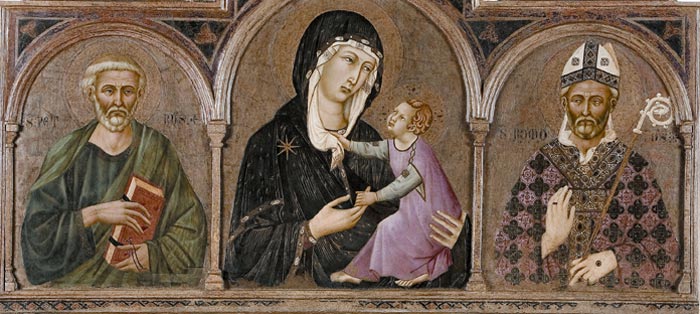 |
||||
| Certaldo’s Onion |
||||
The agricultural traditions, the climate, and the hilly environment find expression Boccaccesca market in Certaldo. |
||||
Boccaccesca is a festival for wine and food lovers, where you can taste the best wine and products from the region. Weekly Market Certaldo: Wednesday Tourist Information Office - Certaldo |
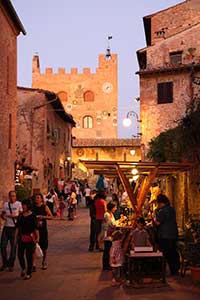 Boccaccesca market in Certaldo |
|||
| [1] Site of settlements already in Etruscan times, Certaldo derives its name from the Latin cerrus altus, or from the Germanic cerrus aldo, both meaning "Turkey oak covered height." Until 1164, the fief of Certaldo belonged to the counts Alberti di Prato. Following the transit of Frederick I known as Barbarossa, the castle was expropriated and transformed into a major vicarage which, in the following years, hosted 705 vicars, to whose presence bear witness the respective coats of arms, still visible on the external façade and within the Palazzo Pretorio [Praetorian Palace]. After 1415 and through the whole republican and Medicean period, Certaldo is the seat of the Vicarage, the most important political and judicial centre of the Valdelsa, Val di Pesa, and part of the Valdarno. Now an important merchant town, Certaldo is home to the family of Giovanni Boccaccio (1313-1375) who lives here at various times in the house now open to the public as a Museum. In Florence, while transcribing Dante's works, received from Petrarch (hence the saying "the third poet passes to the second the works of the first"), Boccaccio contracts the plague, returns to Certaldo to complete the transcription, and dies here. The Church of the St. Jacopo and Filippo houses the bones of the poet whose epitaph is the work of Coluccio Salutati. Certaldo has been one of Italy's 100 cities with 25 podesterie (or municipalities) under itself, and has hosted famous families; besides Boccaccio's, let us recall the Machiavellis and the Arenas whose names are still borne by the towers of ancient standing. As commerce grew along the Francigena, between the 17th and 18th centuries, Certaldo expanded to the lower town. The Palazzo dei Vicari [Vicars' Palace] remained, up to 1866, the seat of the Town's Administration, moved later to the present Town Hall. The Palace was then sold to private owners who ruined it, until the Town bought it back restoring its earlier splendour. Even The Propositura [Main Parish] of St. Tommaso, once located in the present Church of St. Tommaso and Prospero (beside the Palazzo Pretorio), was moved to the Oratory of St. Andrea (1754, in Borgo Garibaldi) and later to the church of Piazza Boccaccio, whose construction began in 1843. In the 80s, tourism emerges as another important economic activity: with the Valdelsa, Certaldo becomes a destination of European and international tourism. The Historical Borgo, also called 'The Castle', is bound within the walls, still largely preserved, through which open the ancient town's access gates: Porta Alberti, Porta del Sole and Porta al Rivellino. The Borgo can be reached by climbing the ancient and evocative steep streets named Costa Alberti and Costa Vecchia, or by the more recent Via del Castello. The sight before the visitor is that of a rare example of medieval urban planning culminating in the imposing Palazzo Pretorio at the top of Via Boccaccio. The square was the main characteristic of medieval towns; all the power centres of the era (religious, political, civil, and commercial) overlooked it. Certaldo grew on an oblong elliptically shaped hill that left no space for the 'square, whose function was then taken by the present Via Boccaccio which is indeed fronted by the Church, the Palace of the authorities (Palazzo Pretorio), and the Logge del Mercato [Market Halls], now closed. The spaces that we can now identify as squares were at the time only vegetable gardens that would supply food to the population in case of siege. [1] Certaldo’s Onion is characterised by a special sweetness and flavour; it is not sharp and its shape is compressed at the poles. It is light purple and has a moist consistency. The ideal soil for the cultivation of Certaldo’s Onion must be loose, with a proportion of clay not higher than 30%, a medium mixture. It needs a moist climate, but not watering. Sowing is done twice per year: in July - August for the “statina”, in October - November for the “vernina.” The statina is transplanted in October and November, it is ready for fresh consumption in May (small bulbs), and it ripens fully in August. The vernina is transplanted in March-April and is ready for winter consumption in late August. It is best stored in fresh, ventilated places; it does not need darkness. Excessive humidity and heat spoil it. The Presidium, started thanks to the support of the Consortium Certaldo 2000, aims at relaunching this culture through the reclamation of abandoned fields and the start up of a cooperative for the packaging and marketing of the product. [Source:Certaldo, a medieval jewel in Tuscany’s green heart | www.toscananelcuore.it]
|
||||
Bibliography |
||||
|
||||
|
||||
Podere Santa Pia |
Podere Santa Pia, giardino |
Colle di Val d'Elsa |
||
 |
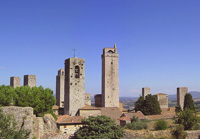 |
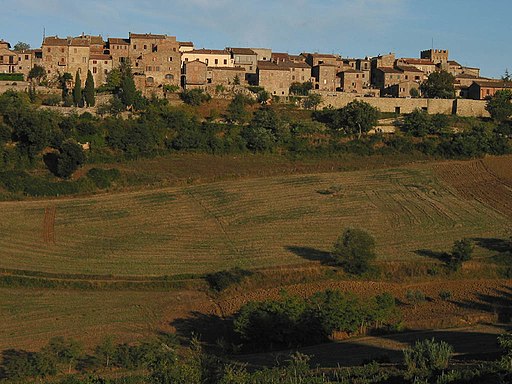 |
||
| San Gimignano, morning |
|
San Gimignano |
Casole d'Elsa | |
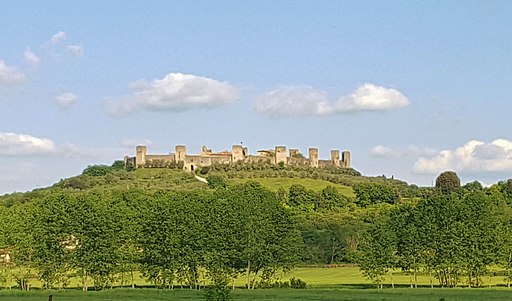 |
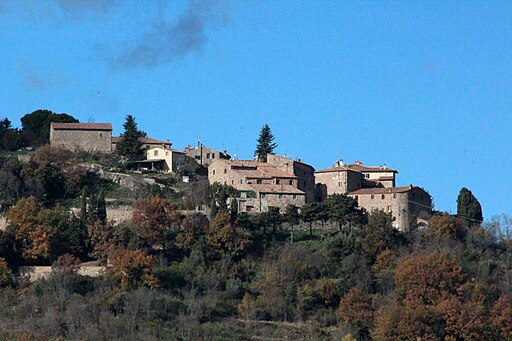 |
 |
||
| Monteriggioni | Mensano, frazione di Casole d'Elsa | Abbazia dei Santi Salvatore e Cirino (Abbadia Isola)
|
||
| The Elsa Valley |
||||
The Elsa Valley (Val d'Elsa) lies between Florence, Siena and Volterra. Traces of human activity date back to the Etruscan period, 6th century BC. Up until the 5th century AD, it was the site of a Roman colony known as "Agro Florentina". The area witnessed the intricate events of the Middle Ages, in particular the rule of the Lombards under King Desiderius and of the Franks under Charlemagne. "Se la gente ch'al mondo più traligna, "If the people that of all this world are most degenerate had not been a stepmother to Caesar, but kind like a mother to her son, there is one turned Florentine that trucks and trades who would be sent back to Semifonte, where his grandfather went a-begging" (The Divine Comedy, Paradiso, canto XVI, vv. 58-63) (Translation: John D. Sinclair) Places to visit |
||||
 |
 |
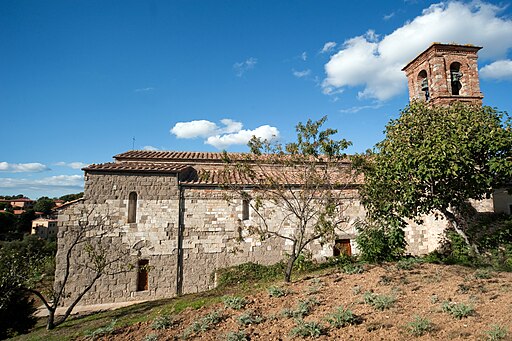 |
||
Colle Val d'Elsa, Le Caldane
|
Monteriggioni e Dante Alighieri
|
Fiancata sinistra della pieve di San Giovanni Battista a Mensano
|
||

